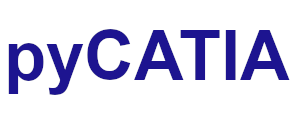pycatia.in_interfaces.move¶
Module initially auto generated using V5Automation files from CATIA V5 R28 on 2020-07-06 14:02:20.222384
Warning
The notes denoted “CAA V5 Visual Basic Help” are to be used as reference only. They are there as a guide as to how the visual basic / catscript functions work and thus help debugging in pycatia.
- class pycatia.in_interfaces.move.Move(com_object)¶
Note
CAA V5 Visual Basic Help (2020-07-06 14:02:20.222384)
System.IUnknownSystem.IDispatchSystem.CATBaseUnknownSystem.CATBaseDispatchSystem.AnyObjectMoveRepresents an object associated with any kind of objects which retrieves thecorresponding movable object.An object can be moved only if it is independent from other objects. Forexample, a pad can be moved, and is as such a movable object, while an edgecannot be moved individually. It should be moved with all the objects making upthe pad to which it belongs as a whole. In this case, the underlying edge’smovable object is the pad.- apply(i_transformation_array: tuple) None¶
Note
CAA V5 Visual Basic help
Applyo Sub Apply(iTransformationArray)Applies a move transformation to a movable object.Parameters:TransformationArrayThe linear transformation array initialized successively by thefour columns of the transformation matrix.The first nine components represent the rotation matrix.The last three components represent the translation vector.Examples:This example applies the transformation (45 degrees-rotationaround the x axis and a translation) stored inTransformationArray to the Move object associated withmyMovableObject:Dim TransformationArray( 11 )‘Rotation( 45 degrees around the x axis) componentsTransformationArray( 0 ) = 1.000TransformationArray( 1 ) = 0TransformationArray( 2 ) = 0TransformationArray( 3 ) = 0TransformationArray( 4 ) = 0.707TransformationArray( 5 ) = 0.707TransformationArray( 6 ) = 0TransformationArray( 7 ) = -0.707TransformationArray( 8 ) = 0.707‘Translation Vector (10,20,30)TransformationArray( 9 ) = 10.000TransformationArray( 10 ) = 20.000TransformationArray( 11 ) = 30.000MyMovableObject.Move.Apply TransformationArray- Parameters:
i_transformation_array (tuple) –
- Return type:
None
- property movable_object: Move¶
Note
CAA V5 Visual Basic help
MovableObjecto Property MovableObject() As (Read Only)Returns the movable object associated with the used object.Example: This example retrieves the myMovableObject fromMove object associated with MyObject. Dim myMovableObject AsMove Set myMovableObject = MyObject.Move.MovableObject- Return type:
